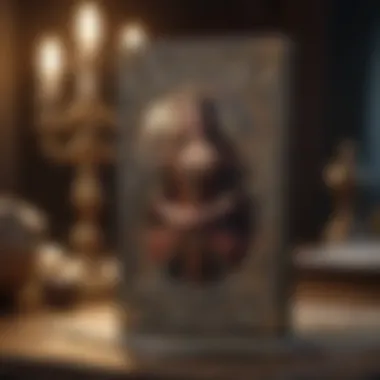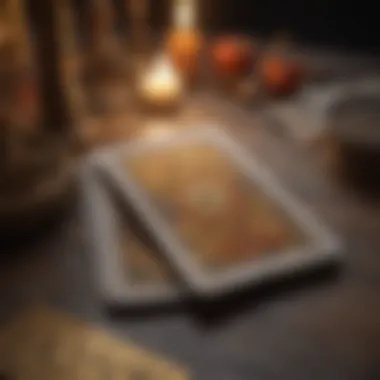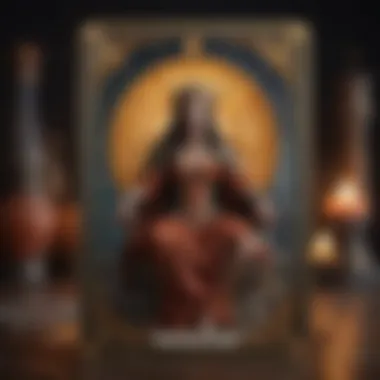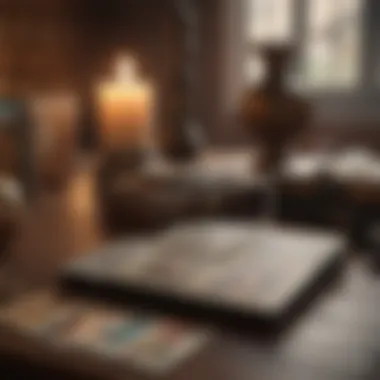Good Tarot Card Decks: A Comprehensive Guide


Intro
The world of tarot card decks is vast and intricate. Each deck holds the potential to unlock deep insights and facilitate self-exploration. This guide delves into essential aspects of tarot decks, including their historical background, artistic variations, and practical considerations for those embarking on their tarot journey.
Selecting the right tarot deck is a personal choice. The significance of aesthetic appeal, symbolism, and usability all come into play. Understanding these elements enables both newcomers and experienced practitioners to find a deck that resonates with their unique journey.
Exploring the unique characteristics of various tarot decks can further enhance one's tarot practice. It sheds light on why some decks may speak to an individual more profoundly than others. Moreover, the practical tips presented here assist readers in making informed decisions, whether they are acquiring a deck for personal use or as a gift for someone else.
Throughout this guide, we aim to provide insightful perspectives on good tarot card decks, equipping readers with the knowledge necessary to enhance their understanding of tarot as a tool for introspection and divination.
Preface to Tarot Card Decks
Understanding the landscape of tarot card decks is crucial for anyone interested in this esoteric practice. Tarot is not merely a set of cards; it represents a profound system of symbols, archetypes, and narratives that assist individuals on their spiritual or psychological journeys. Tarot card decks are varied, with distinct artworks, themes, and philosophies. This diversity invites both novice and seasoned practitioners to learn, explore, and engage in personal growth.
The choice of a tarot deck plays a significant role in a reader's experience. Different decks can evoke varying emotions and resonate differently with individuals. Selecting a deck that aligns with one's personal or spiritual beliefs enhances the reading experience, providing deeper insights and connections. Thus, understanding tarot decks involves knowing their purpose, cultural significance, and personal relevance to a reader's life.
Understanding Tarot
Tarot cards typically consist of 78 cards divided into two main categories: the Major Arcana and the Minor Arcana. The Major Arcana represents significant life lessons and karmic influences, often depicting archetypal figures and themes. The Minor Arcana, on the other hand, deals with everyday events and experiences, illustrating the more mundane aspects of life.
These cards are steeped in symbolism, with every image carrying multiple layers of meaning. For example, the Fool symbolizes new beginnings, spontaneity, and taking risks, while the Empress embodies fertility, abundance, and nurturing. Understanding these symbols is key to effectively using tarot cards, as it provides readers with the tools to interpret their messages accurately.
Importance of Choosing the Right Deck
When it comes to tarot reading, the choice of deck significantly influences the intuitive and interpretive process. A well-suited deck can resonate with the reader, visually and conceptually. The right cards not only enhance clarity during readings but also improve the reader's comfort level. Practitioners should consider several factors, including:
- Artistic Style: The visual aesthetics of a deck should appeal to the reader’s sensibilities. For example, some prefer traditional designs like the Rider-Waite, while others might favor contemporary styles that reflect current societal themes.
- Symbolism: Each tarot deck carries its unique interpretations of traditional symbols. Understanding these differences informs how the reader connects with the cards.
- Personal Connection: A deck should evoke an emotional or spiritual reaction. Whether through colors, themes, or even the tactile feel of the cards, this connection can deepen the reading experience.
- Purposefulness: Consider why the tarot deck will be used. Is it for personal readings, spiritual work, or gifting? The intended use can help determine the best deck to choose.
Historical Background of Tarot
The historical background of tarot is essential to understanding its significance and evolution as a divination tool. By tracing the developments in tarot card designs, symbolism, and usage, readers can gain a deeper insight into how these decks have reflected cultural beliefs and practices over centuries. This perspective not only enriches one’s experience with tarot but also aids practitioners in forming a meaningful connection with their chosen deck. The evolution of tarot reflects the changing values and ideas in society, marking it as a fascinating area of study within esoteric traditions.
Origins of Tarot Cards
The origins of tarot cards remain somewhat shrouded in mystery, with various theories proposing different beginnings. Most scholars agree that the first tarot decks emerged in the 15th century in Europe, most notably in Italy. Early decks, such as the Visconti-Sforza cards, were designed for playing games and had no known connection to divination. The artistic craftsmanship in these early decks set a precedent for future tarot decks.
The connection to mysticism appeared later, likely in the 18th century. It was during this time that tarot became associated with the occult, a shift led by figures such as Antoine Court de Gébelin, who theorized that tarot cards contained ancient Egyptian wisdom. This interpretation sparked interest in tarot as a divinatory tool rather than merely for gaming.
Evolution of Tarot Decks Over Time
As tarot gained popularity, several distinct decks emerged, each reflecting the artistic and cultural influences of its time. The 20th century saw the creation of some of the most recognized decks in history, including the Rider-Waite Tarot, designed by Arthur Edward Waite and illustrated by Pamela Colman Smith. This deck introduced vivid imagery and symbolism that made tarot more accessible for beginners.
Today, the evolution of tarot continues with modern and themed decks proliferating the market. Artists and creators are exploring diverse themes, from nature and spirituality to popular culture, providing practitioners with options that cater to their personal tastes.
The significance of this evolution lies not only in the visual representation but also in how these changes mirror societal shifts. Tarot has transitioned from a game to a tool for introspection and understanding, embracing a broader audience and cultures along the way. Readers can track these developments through various decks, appreciating their historical context and the imagery that speaks to the human experience.
"Understanding the history of tarot enriches your reading experience, connecting the past with personal insight."
By recognizing the origins and evolution of tarot decks, practitioners can approach their readings with a new appreciation. Each card carries weight and meaning shaped by centuries of cultural significance.


Categories of Tarot Decks
Understanding the categories of tarot decks is crucial for both beginners and advanced practitioners. Each type of deck provides a unique perspective and approach to tarot reading. This section will explore various categories of tarot decks, highlighting their characteristics and benefits. Learning about these different types can guide you in selecting a deck that aligns with your personal style and intentions.
Traditional Tarot Decks
Traditional tarot decks, such as the Rider-Waite and Thoth decks, form the foundation of tarot reading. These decks consist of 78 cards divided into the Major Arcana and Minor Arcana. The Major Arcana includes 22 significant cards that represent major life events and themes. The Minor Arcana comprises four suits, each containing 14 cards that symbolize day-to-day experiences.
The imagery in traditional decks is rich in symbolism. For example, the Rider-Waite deck is well-known for its detailed illustrations and clear visual messages. Readers often find it easier to interpret these cards due to the consistent iconography across cultures and traditions.
Modern and Artistic Decks
Modern and artistic decks diverge from traditional representations, offering innovative designs and interpretations. Artists create these decks to share their unique visions of tarot. They may incorporate different styles, such as abstract art or photography, into their cards. Examples include the Wild Unknown Tarot and the Modern Witch Tarot.
These decks often resonate with younger audiences or those looking for a fresh take on tarot. The artistic expression can inspire new interpretations and allow readers to connect emotionally with their decks in a unique way. However, some may find the departure from traditional symbolism challenging, which is an important consideration when choosing a deck.
Themed Tarot Decks
Themed tarot decks draw inspiration from specific topics, cultures, or interests. Examples include the Animal Spirit Tarot, which uses animal symbols for divination, or the Steampunk Tarot that fuses elements of science fiction and vintage aesthetics. These decks provide a playful approach to tarot and can appeal to diverse audiences.
Choosing a themed deck can enhance one's personal connection to the cards. It allows practitioners to dive deeper into their interests while exploring tarot. The drawback is that particular themes may narrow the scope of interpretations, potentially making readings less universal. A clear understanding of the theme's context is vital for effective readings.
Oracle and Specialty Decks
Oracle decks differ fundamentally from traditional tarot decks. They typically feature a variety of cards, usually ranging from 30 to 60 in number, and do not follow the strict structure of tarot. Each oracle deck centers around a specific theme, making their offerings flexible and versatile. Popular examples are the Work Your Light Oracle and the Moonology Oracle.
Specialty decks can also address specific topics such as self-care or empowerment. These decks often aim to evoke intuition and personal insights. Although they may lack the comprehensive nature of traditional tarot, they serve as valuable tools, especially in conjunction with tarot readings. Oracle and specialty decks can enrich one's intuitive practices, broadening perspectives on personal challenges.
Understanding these categories will help you appreciate the diverse landscape of tarot decks. Each type serves a particular purpose, from profound psychological work to casual exploration of spirituality. Take your time to explore these options thoroughly, ensuring your next tarot deck resonates with your personal journey.
Artistic Styles in Tarot Decks
The artistic style of a tarot deck goes beyond mere aesthetics; it plays a crucial role in how users connect with the cards. Each art style can evoke distinct emotions and interpretations, anchoring the reading experience in personal resonance. This connection is vital for effective readings and deeper understanding of the cards' meanings.
Different styles can offer various benefits. For instance, minimalist designs might appeal to those who prefer clarity and simplicity. Conversely, intricate artwork can inspire deeper exploration and intuition, offering layers of meaning that invite contemplation. Additionally, the artistic style often reflects the deck's theme or intent, making it essential to choose a deck that aligns not just with personal taste but also with the intended use of the cards.
In selecting a deck, it is important to consider not just the visual appeal but also how the imagery resonates on a psychological level. Art in tarot serves as a bridge between the reader’s psyche and the universal archetypes represented by the cards. Here, we will delve into specific elements that define artistic styles in tarot decks, their cultural influences, and the contributions of notable artists.
Key Factors to Consider When Choosing a Tarot Deck
Choosing a tarot deck is not a trivial decision. It can significantly shape your experience and understanding of tarot as a practice. In this section, we will delve into key factors that can guide your selection process. Each aspect is crucial in determining which deck resonates with you, enhances your readings, and ultimately supports your journey in tarot.
Personal Resonance with the Deck
Personal resonance plays a vital role in selecting a deck. It refers to the connection you feel towards a particular set of cards. Each tarot deck conveys unique imagery, themes, and symbolism. This connection can stem from personal beliefs, life experiences, or aesthetic preferences.
For example, if you are drawn to nature, a deck with earthy imagery may resonate more. Conversely, individuals who favor abstract art might find modern or artistic decks appealing. Consider how the imagery speaks to you. A deck that feels aligned with your personal perspective can facilitate a deeper understanding of the cards and enhance your intuitive readings.
Quality of the Card Stock and Print


Quality is another critical factor when choosing a tarot deck. Card stock refers to the materials used to make the cards. High-quality card stock will feel durable and withstand frequent shuffling. Poor quality cards may bend easily or wear down over time, which can detract from your reading experience.
Additionally, the quality of print affects the clarity of symbols and details on each card. Cards with clear and bold illustrations facilitate easier interpretation during readings. When considering a deck, look for reviews or images showing the card quality. Investing in a well-printed deck can have a long-term positive impact on your practice.
Ease of Use and Accessibility
Finally, ease of use and accessibility must not be overlooked. Tarot can be an intricate system, often requiring familiarity with various interpretations. A deck that is easy to handle and navigate is essential for both beginners and experienced readers.
Some decks feature comprehensive guidebooks that aid in understanding card meanings and spreads, enhancing your overall experience. Additionally, consider the size and shape of the cards. A standard size might be suitable for most, but if you have smaller hands, look for decks that cater to that need. The goal is to ensure that the deck feels comfortable and intuitive in your hands during your practice.
A well-chosen tarot deck not only reflects personal taste but also aligns with your spiritual exploration and growth. Finding the right one can be an enriching aspect of your tarot journey.
Notable Tarot Decks to Explore
When delving into the world of tarot, it is essential to recognize significant tarot decks that have shaped the practice. Familiarizing oneself with notable decks offers insight into different interpretative approaches, artistic styles, and historical contexts, enhancing both the understanding and application of tarot. Choosing the right deck is a personal journey, guided by individual preferences and intent.
Rider-Waite Tarot
The Rider-Waite Tarot is perhaps the most recognized and widely used deck in the world. Created by Arthur Edward Waite and illustrated by Pamela Colman Smith in the early 20th century, this deck has set the standard for modern tarot. Its significance lies not only in its imagery but also in its clear symbolism, making it accessible for beginners and experienced readers alike.
The Rider-Waite deck features 78 cards, divided into the Major and Minor Arcana. Its illustrations vividly depict everyday scenarios, enabling users to relate to the messages conveyed. The imagery is particularly beneficial in facilitating intuitive readings, allowing the reader to connect with their instincts and insights. Overall, this deck serves as a reliable foundation for anyone exploring tarot.
Thoth Tarot
Developed by the influential occultist Aleister Crowley and artist Frieda Harris during the early 20th century, the Thoth Tarot presents a complex and richly layered system. This deck, characterized by its deep esoteric symbols and intricate artwork, draws on various mystical traditions, including Kabbalistic and alchemical teachings.
Each card in the Thoth deck is filled with meanings and intricacies, requiring a thoughtful approach when interpreting its messages. It appeals to those who seek deeper esoteric knowledge, and its artwork is unique in its bold colors and abstract designs. This deck often resonates with more advanced practitioners who appreciate its depth and historical context.
Wild Unknown Tarot
The Wild Unknown Tarot, created by Kim Krans, emerged as a modern classic since its release in 2016. This deck distinguishes itself through its minimalistic and naturalistic artwork, characterized by hand-drawn illustrations of animals, plants, and other elements from the natural world.
The focus on nature promotes a fresh perspective on tarot readings, emphasizing a connection to the earth and personal intuition. This deck's straightforward symbolism encourages users to rely on their inner wisdom, making it ideal for readers looking for a grounded experience. Like the Rider-Waite, it is especially suitable for practitioners who resonate with more intuitive, personal tarot practices.
Modern Witch Tarot
The Modern Witch Tarot by Lisa Sterle is a contemporary take on traditional tarot themes, aimed primarily at a diverse and inclusive audience. This deck embraces modern imagery, featuring characters in various body types, ethnicities, and styles, reflecting a broader representation of society.
With vibrant artwork and inclusive themes, the Modern Witch Tarot encourages users to connect with their unique identities while exploring their journeys through tarot. It is especially relevant for those who appreciate pop culture references and a modern aesthetic, making it a sensational choice for younger or new readers. The relatable visuals can facilitate ease of understanding and connection with the tarot.
"The beauty of tarot is in its flexibility; each deck tells a unique story relevant to the reader's personal journey."
Familiarity with these notable tarot decks allows practitioners to understand the range of interpretations and styles available. Each deck brings something unique, providing tools for introspection and divination tailored to individual experiences.
Practical Tips for Using Tarot Decks
Using tarot decks effectively can enhance your experience with them, whether you are a novice or an experienced practitioner. The practical tips outlined below offer guidance to help you connect with your cards more deeply. By following these suggestions, you can create a more enriching learning experience and foster a meaningful relationship with your tarot deck. They emphasize importance of rituals, cleansing, and interpreting cards accurately.
Cleansing and Charging Your Deck


Cleansing your tarot deck is crucial for maintaining its energy and ensuring that it is free from any negative influences or unwanted attachments. Cards can absorb energies from the environment, especially if they are used frequently. Therefore, taking time to cleanse them can restore their vibrancy. Common methods for cleansing include:
- Smoke Cleansing: Passing your deck through the smoke of sage or palo santo.
- Salt or Rice: Leaving the cards in a bowl of salt or rice to absorb unwanted energies.
- Moonlight Exposure: Placing your cards in the light of the full moon to recharge.
After cleansing, it is advisable to charge your deck, which involves setting intentions and connecting with the essence of the cards anew. This process ensures that your readings are aligned with your focus and inquiry.
Establishing a Ritual for Readings
Having a ritual for your tarot readings can create a sacred space that encourages focus and openness. The ritual does not need to be complex or elaborate; what matters is that it resonates with you. Here are a few steps you can take to establish an effective ritual:
- Choose a Comfortable Space: Find a quiet location where you can concentrate without distractions.
- Set an Intention: Before starting, take a moment to reflect on what you seek from the reading.
- Ground Yourself: Consider grounding techniques, such as deep breathing or visualization, to help center yourself.
- Create an Atmosphere: Light a candle, burn incense, or play calming music to set the mood.
Adopting such rituals signals to your mind that you are entering a special moment of introspection and connection with your cards.
Interpreting the Cards
Interpreting tarot cards is an art that combines intuition with learned symbolism. Each card has inherent meanings that can shift depending on its position and the context of your question. Here are some strategies to enhance your interpretation skills:
- Familiarize with Card Meanings: Create a personal reference guide that includes keywords and associations for each card.
- Trust Your Intuition: Allow your instincts to guide you. Sometimes the meanings of the cards will align more with your feelings or present circumstances than with traditional interpretations.
- Context Matters: Always consider the context of the reading. The surrounding cards will provide additional insights that can modify the individual meanings of each card.
Important: Regular practice will sharpen your skills. Using spreads frequently, journaling your readings, and reflecting on their outcomes will improve your ability to interpret the cards over time.
Incorporating Tarot into Personal Development
In recent years, more individuals have shown interest in integrating tarot into their personal growth paths. This section aims to elucidate the relevance of tarot as a tool for introspection and self-exploration, particularly for those seeking deeper understanding of their inner selves and life paths. Engaging with tarot can offer significant benefits, including clarity of thought, emotional healing, and a structured approach to self-reflection.
Choosing to incorporate tarot into personal development allows individuals to tap into their psychic instincts and interpret feelings and situations in a new light. Unlike conventional methods of introspection, tarot provides a tangible framework for examining one's thoughts, feelings, and experiences. The cards serve as a mirror, reflecting aspects of the self that may be neglected or overlooked.
Using Tarot for Introspection
Tarot can facilitate introspection by prompting deep and meaningful questions. Each card holds unique symbolism and significance, allowing users to delve into their thoughts and feelings. For example, drawing the Two of Swords could represent an internal conflict, urging one to face and explore the indecision. This exploration can lead to insights that may not be readily accessible through regular journaling or meditation practices.
When using tarot for introspection, consider the following:
- Select a suitable deck: The deck should resonate with your personal beliefs and aesthetics to enhance connection.
- Set a clear intention: Before starting a reading, define what aspect of your life you'd like to explore.
- Focus on the symbolism: Each card has unique meanings, both upright and reversed. Think about how these meanings relate to your current situation.
The act of interpreting cards encourages active participation in one’s emotional narrative. Thus, the tarot serves as a conduit for deeper self-awareness, leading to guided decision-making and profound insights.
Tarot in Meditation and Mindfulness
Beyond introspection, tarot can also play a crucial role in meditation and mindfulness practices. By drawing a card before meditation, one can set an intention for the session. The chosen card acts as a focal point, guiding thoughts and feelings during the practice.
Here are some points to consider while incorporating tarot into meditation:
- Preparation: Create a serene environment and focus on the card's imagery. Allow it to absorb your attention as you ease into a meditative state.
- Reflection: Post-meditation, take some time to reflect on how the card's energy influenced the experience. Note any thoughts or feelings that arose during meditation.
- Integration: Consider how insights gained during this practice can fit into daily life and broader personal development goals.
Tarot thus becomes not just a tool for divination but also a vehicle for mindfulness. It aids in cultivating an awareness of the present moment, allowing users to ground themselves in their experiences while gaining clarity.
Closure
The role of tarot card decks in personal development and introspection cannot be overstated. As we have explored in this article, the right deck serves as more than mere tools for divination; they are avenues for self-discovery, empowerment, and transformation. The decision to embrace a specific tarot deck is often deeply personal. Each deck comes with its unique symbolism and energy, which resonates differently with individual users.
When selecting a tarot card deck, consider the elements that align with your personal journey. Factors such as artistic style, symbolism, and the emotional connection to the deck can significantly influence the reading experience. It is not just about functionality; it is about the resonance with you. Understanding this connection is essential when navigating your tarot practice.
Moreover, incorporating tarot into your life offers multiple benefits. It can help enhance emotional intelligence and provide clarity in times of uncertainty. The insightful messages gleaned from readings foster a deeper understanding of oneself and one's circumstances, thus promoting inner peace and growth.
"Tarot is a journey, not a destination. Each card invites reflection and exploration of our paths."







